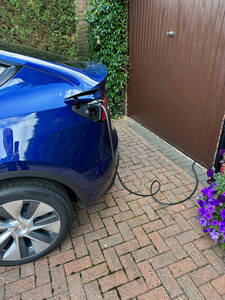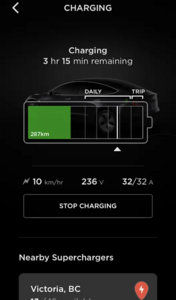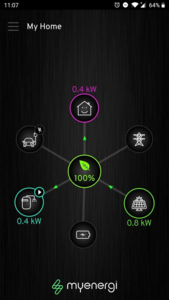This page will reflect the most common charging Home charging the EV car our Tesla. I described the Supercharger experience here. That was very good and very quick.
On 19th August we plugged the car in using the supplied type 2 connector to UK 13 Amp Mains plug. All very simple once unwrapped from plastic. The cable and the main Type 2 for other chargers were in the boot. The mains cable is in a nice case. Plug the plug connector/adapter into the socket then into any mains plug. Next plug other end into top socket. Light on car went blue then green to show charging. Plug end pulsed lights on plug connection.

Home Charging – Normal Mains
The car showed what was happening on the big screen. Time to charge estimate and charging rate.

Our plug-in is using a standard mains plug in our garage, which you couldn’t fit a car in even before I stole half of it, had a maximum output on the app of 10 amps. This was adjustable downwards. Which we did playing with the solar report until we still had net export at 6 amps for charging whilst still generating. Unlike the picture above it stated 16 hours at 10 amp capability for full charge. Now longer at 6 amps closer to 24 hours, zzzzzzz. As the sun comes out we will play with this manually until we get our own dedicated home charger.
According to the App we charged 26kw/h at a cost of £5 i.e. more than the supercharger cost; however, this is incorrect. The app lets you set the current home per kw/h rate, but does not consider that we only charged during the day when our solar was exporting. Until we have the home charge, where we can set to only charge from solar, we won’t be able to calculate.
The real cost would have been zero if all the power came from solar at that time. It wasn’t all zero as the partial cloud meant the export rate (shown on solar) sometimes showed importing. I would state that the process on the mains charge is slow.
Zappi
We’ve ordered a Myenergy Zappi PV 2 via Octopus Energy. They offer competing models and no you don’t have to be an energy customer. It was installed in September when I’ll update this section on the experience. See below.
Zappi Power
It’s a 7.2kw/h system using a 30 amp dedicated circuit on a single phase mains supply. Three phase for 22kw/h are available and compatible if we had three phase. Using this connector a full charge should take 84.7kw/h (not all usable) dived by 7.2 Kw/h. That’s 11 hrs but nothing is as straightforward. Estimate is 7-8 hrs to recharge usable capacity which is closer to 60kw/h for advertised warm weather range of 320 miles. We’ll be monitoring actual performance – I’m hoping to average about 280 miles.
Given solar comments above its also worth noting that our system cannot output at 7.2kw/h only 3.5 if all power went that way and solar was at full power. That’s still faster than the trickle at 6 amp. The bottom line is that if you want fast you have to pay for it.
There is one alternative which I’m still investigating, in that some battery systems can charge at faster rates (even if capacity is less) e.g. 22kw/h rate is possible until battery is depleted. For Tesla’s Powerwall that would be a max capacity of 13.2kw/h at a rate of 22kw/h. Forty minutes of charge at that rate using just battery to get the car to approx third charge.
Zappi Installation
The Zappi was installed on 10th September. One issue on the Zappi was the wrong colour unit, we wanted black a white/grey was installed. This is a clip on cover so we awaited a replacement. Another issue was circuit monitoring. To do full solar monitoring would need another monitoring clip on solar output, to go with one supplied for mains power. That wasn’t explained or supplied.
Zappi App
We can see the difference on the Owl software dashboard and in the My Energy Zappi application in the difference from mains supply to car charging. The extra monitoring would show a solar connection delivery.

Zappi Wireless
Had some messing around with Wi-Fi set up. Installer wanted to use WPS but my mesh Wi-Fi doesn’t allow that. So, I had to manually set up charger as hot spot. Connect a tablet to it then force the Zappi onto my home network. Also later configured lock security etc. To prevent charger being used by anyone that wanted to plug in. Rate can also be controlled in Tesla App i.e. what the car will receive.
Home Charging – Zappi Use
Simple plug in to the car. Zappi has multiple modes. Fast pulls in full 30 Amp 240v feed to give 7.2kw/h rate. All from mains if that is all that is running. Eco, and Eco+ with variations on rates and timing can also be established. Eco trickles in unless Solar kicks in which is at around 1.4Kw/h output.
The Zappi app also allows cost monitoring. We have now switched our supplier from Utility Warehouse to get Octopus who have special deals for EV charging including a 6 hour 7.5p per kw/h system. Ideal for charging the battery and car.
Future Plug Less
Tesla have purchased a German wireless vehicle charging company. We’ve seen that with mobile phones. It will save cables and space. Compatibility with existing car – you’ve seen phones so I don’t expect it.


